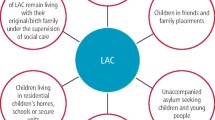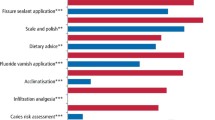Abstract
Introduction Poor oral health in children may be a marker for wider neglect and abuse, but there is no universally recognised threshold for social services intervention.
Aim To compare families' thresholds for referral for social services intervention with those of healthcare workers.
Intervention Five standardised vignettes, used previously to investigate the views of healthcare workers on the need for social services intervention, were used to determine the threshold of 250 families for intervention.
Results For an unkempt four-year-old girl with extensive dental caries frequently not brought to appointments, 63.6% families suggested a child in need (CIN) referral, against 9% (3/32) dental professionals (p <0.001) and 38% (38/100) paediatric healthcare professionals (PHCPs) (p <0.001). For a bullied, obese 14-year-old boy with extensive dental caries, similar proportions of families (37%; 93/250) and PHCPs (40%; 40/100) advised a CIN referral (p = ns); significantly fewer dental workers did (15.6%; 5/32; p = 0.017). Concerning a four-year-old boy with a bruised ear, over 64% of families and 68% of PHCPs correctly felt engagement with social services was necessary (p = ns) compared to just 12.5% (4/32) of dental practitioners (p <0.001).
Conclusion Many parents felt social services involvement would be helpful in these hypothetical cases, often more frequently than healthcare workers.
Key points
-
There is currently no recognised threshold for dental neglect.
-
Families have a lower threshold for social services involvement, either as a child in need or child protection referral, than dental professionals.
-
Neglect and abuse must be considered for children with high levels of dental caries.
This is a preview of subscription content, access via your institution
Access options
Subscribe to this journal
Receive 24 print issues and online access
$259.00 per year
only $10.79 per issue
Buy this article
- Purchase on Springer Link
- Instant access to full article PDF
Prices may be subject to local taxes which are calculated during checkout
Similar content being viewed by others
References
Morgan M. Picture of Oral Health 2017. Cardiff: Cardiff University, 2017.
Fayle S, Welbury R, Roberts J. British Society of Paediatric Dentistry: a policy document on management of caries in the primary dentition. Int J Paediatr Dent 2011; 11: 153-157.
Bhujel N, Duggal M, Saini P, Day P. The effect of premature extraction of primary teeth on the subsequent need for orthodontic treatment. Eur Arch Paediatr Dent 2016; 17: 423-434.
Watt E, Ahmad A, Adamji R, Katsimbali A, Ashley P, Noar J. Space maintainers in the primary and mixed dentition - a clinical guide. Br Dent J 2018; 225: 293-298.
UK Government. Children Act 1989. 1989. Available at https://www.legislation.gov.uk/ukpga/1989/41 (accessed January 2020).
UK Government. Children Act 1989 Part III. 1989. Available at http://www.legislation.gov.uk/ukpga/1989/41/part/III (accessed January 2020).
UK Government. Children Act 1989 Part V. 1989. Available at http://www.legislation.gov.uk/ukpga/1989/41/part/V (accessed January 2020).
Welsh Government. Wales Children Receiving Care and Support Census, 2019. 2020. Available at https://gov.wales/sites/default/files/statistics-and-research/2020-03/wales-children-receiving-care-and-support-census-2019.pdf (accessed November 2020).
United Nations. Convention on the Rights of the Child. 1989. Available at https://www.ohchr.org/en/professionalinterest/pages/crc.aspx (accessed January 2020).
Harris J C, Balmer R C, Sidebotham P D. British Society of Paediatric Dentistry: a policy document on dental neglect in children. Int J Paediatr Dent 2009; DOI: 10.1111/j.1365-263X.2009.00996.x.
General Dental Council. Standards for the dental team. 2013. Available at https://standards.gdc-uk.org/Assets/pdf/Standards%20for%20the%20Dental%20Team.pdf (accessed January 2020).
The Royal College of Paediatrics and Child Health. Child Protection Evidence - Dental neglect. 2014. Available at https://www.rcpch.ac.uk/resources/child-protection-evidence-dental-neglect (accessed January 2021).
Olive A, Tuthill D, Hingston E, Chadwick B, Maguire S. Do you see what I see? Identification of child protection concerns by hospital staff and general dental practitioners. Br Dent J 2016; 220: 451-457.
Chestnutt I. Addressing oral health inequalities in the United Kingdom- the impact of devolution on population-based fluoride police. Br Dent J 2013; 215: 11-12.
Smitt H S, de Leeuw J, de Vries T. Association Between Severe Dental Caries and Child Abuse and Neglect. J Oral Maxillofac Surg 2017; 75: 2304-2306.
Valencia-Rojas N, Lawrence H, Goodman D. Prevalence of Early Childhood Caries in a Population of Children with History of Maltreatment. J Public Health 2008; 68: 94-101.
SciStat. Fisher exact probability calculator. Available at https://www.medcalc.net/statisticaltests/fisher.php (accessed January 2020).
Acknowledgements
We are grateful to all the families who participated and gave their time for this survey. Thanks are also due to Maria Morgan for the Welsh data.
Author information
Authors and Affiliations
Corresponding author
Ethics declarations
EH - nil. DT - nil. GGR was paid from a paediatric endowment fund supervised by DT to perform this work as a dental student. No commercial funding or influence was received.
Rights and permissions
About this article
Cite this article
Tuthill, D., Guest-Rowlands, G. & Hingston, E. When does childhood dental caries become neglect or abuse: do parents think what we think?. Br Dent J (2021). https://doi.org/10.1038/s41415-021-3569-8
Received:
Accepted:
Published:
DOI: https://doi.org/10.1038/s41415-021-3569-8
This article is cited by
-
Continuing vulnerability awareness
British Dental Journal (2022)



